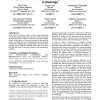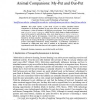1225 search results - page 206 / 245 » Design Principles for Intelligent Environments |
AIIA
2007
Springer
14 years 3 months ago
2007
Springer
Detection of human skin in an arbitrary image is generally hard. Most color-based skin detection algorithms are based on a static color model of the skin. However, a static model c...
ICMI
2007
Springer
14 years 3 months ago
2007
Springer
In this paper, an influence model is used to recognize functional roles played during meetings. Previous works on the same corpus demonstrated a high recognition accuracy using SV...
ILP
2007
Springer
14 years 3 months ago
2007
Springer
A recurrent question in the design of intelligent agents is how to assign degrees of beliefs, or subjective probabilities, to various events in a relational environment. In the sta...
AIED
2005
Springer
14 years 2 months ago
2005
Springer
This paper reports a pilot study of how to utilize simulated animal companions to encourage students to pay more effort in their study in the classroom environment. A class of stud...
MICAI
2005
Springer
14 years 2 months ago
2005
Springer
A powerful and useful approach for modeling knowledge and qualitative reasoning is the Cognitive Map. The background of Cognitive Maps is the research about learning environments c...


